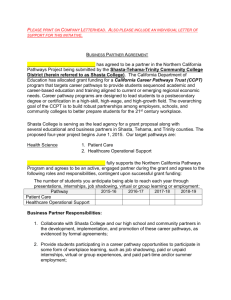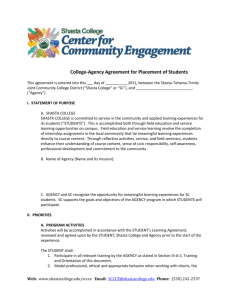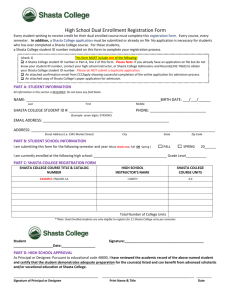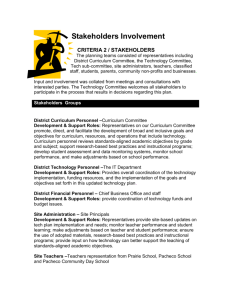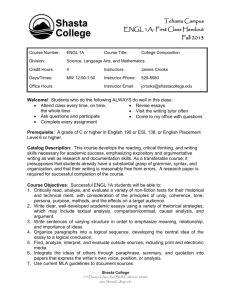project annual report template
advertisement
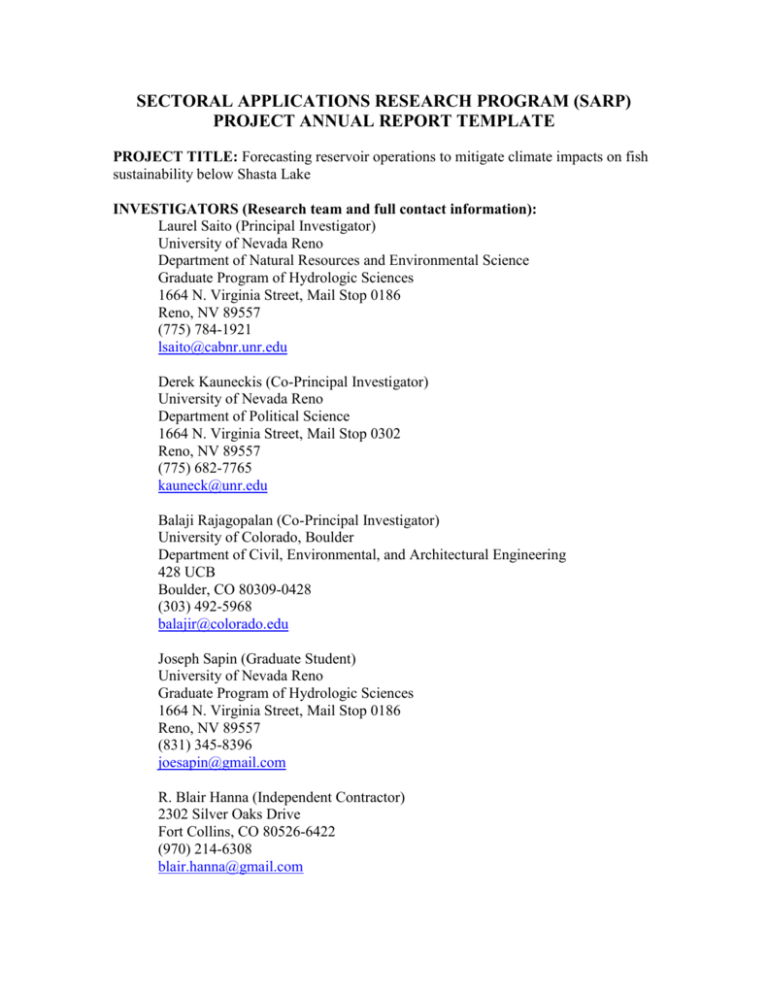
SECTORAL APPLICATIONS RESEARCH PROGRAM (SARP) PROJECT ANNUAL REPORT TEMPLATE PROJECT TITLE: Forecasting reservoir operations to mitigate climate impacts on fish sustainability below Shasta Lake INVESTIGATORS (Research team and full contact information): Laurel Saito (Principal Investigator) University of Nevada Reno Department of Natural Resources and Environmental Science Graduate Program of Hydrologic Sciences 1664 N. Virginia Street, Mail Stop 0186 Reno, NV 89557 (775) 784-1921 lsaito@cabnr.unr.edu Derek Kauneckis (Co-Principal Investigator) University of Nevada Reno Department of Political Science 1664 N. Virginia Street, Mail Stop 0302 Reno, NV 89557 (775) 682-7765 kauneck@unr.edu Balaji Rajagopalan (Co-Principal Investigator) University of Colorado, Boulder Department of Civil, Environmental, and Architectural Engineering 428 UCB Boulder, CO 80309-0428 (303) 492-5968 balajir@colorado.edu Joseph Sapin (Graduate Student) University of Nevada Reno Graduate Program of Hydrologic Sciences 1664 N. Virginia Street, Mail Stop 0186 Reno, NV 89557 (831) 345-8396 joesapin@gmail.com R. Blair Hanna (Independent Contractor) 2302 Silver Oaks Drive Fort Collins, CO 80526-6422 (970) 214-6308 blair.hanna@gmail.com Raymond Jason Caldwell (Collaborator) University of Colorado, Boulder Department of Civil, Environmental, and Architectural Engineering 428 UCB Boulder, CO 80309-0428 (303) 492-5968 caldwerj@colorado.edu NOAA GRANT NUMBER: NA12OAR4310093 PROJECT YEARS: 2012-2014 TIME PERIOD ADDRESSED BY REPORT (e.g., August 2002-March 2003): May 1, 2014 to April 30, 2015 I. PRELIMINARY MATERIALS (Information in this section is standard and may be updated and/or copied from previous progress reports) A. Research project objective. (Limited to one paragraph) We are partnering stochastic weather generation with two-dimensional hydrodynamic modeling of reservoir operations to examine the feasibility of meeting downstream temperature targets for the salmon fishery on the Sacramento River in California below Shasta Lake. The coupling of these modeling approaches will allow us to examine how climate forecasts can be used to inform reservoir operations decisions for downstream fisheries management. Our scientific objectives are 1) to examine the impacts of climate variability on meeting downstream temperature targets for Chinook salmon; 2) to assess current operating guidelines regarding effectiveness in meeting downstream temperature targets; and 3) to determine feasible operating guidelines to meet downstream temperature targets under current and projected climate conditions. In addition, we will interact closely with water managers for the reservoir and the Sacramento River to employ methods of decision-making and institutional analysis to represent how managers make decisions about multipurpose demands in reservoir operations. B. Stakeholders and decision makers with whom you are working (in bulleted form). US Bureau of Reclamation: Paul Fujitani, Tom Morstein-Marx, Paul Sedonis, Thuy Washburn, Kristin White, Rod Wittler, Russ Yaworsky NOAA Fisheries: Eric Danner, Andrew Pike The Nature Conservancy: Ryan Luster, Maurice Hall California Department of Fish and Wildlife: Bob Hughes, Annie Manji Winnemem Wintu Tribe: Jeanne France, David Martinez, Chief Coleen Sisk, Helene Sisk San Francisco State University: Anne McTavish Other: Marc Dadigan (Freelance writer) C. Approach including methodological framework, models used, theory developed and tested, project monitoring and evaluation criteria. Include a description of the key beneficiaries of the anticipated findings of this project (e.g., decision makers in a particular sector/level of government, researchers, private sector, science and resource management agencies). (Limit of one page) Tasks associated with the project include: 1) Development of stochastic daily Shasta Lake inflow scenarios under historic and future climate conditions; 2) Development of stochastic sub-daily Shasta Lake weather scenarios under historic and future climate conditions; 3) Implementation of workshops with reservoir managers to obtain operating guidelines and decision-making criteria; 4) Development and simulation of historic and future climate scenarios with operations guidelines from managers using the CE-QUALW2 model; 5) Assessment of outflow temperatures from CE-QUAL-W2 model regarding meeting downstream temperature targets for the scenario runs; and 6) Dissemination of project results. The project will be developing approaches for linking stochastic generation approaches with hydrodynamic modeling. In regards to project monitoring and evaluation, we have a timeline to complete tasks that we revisit frequently to make sure things are progressing in a timely manner. Key beneficiaries of the findings include decision-makers from the US Bureau of Reclamation who operate Shasta Dam as well as other facilities in the Sacramento River system; California Department of Fish and Wildlife who manage the fisheries in the reservoir and the river; NOAA Fisheries who are concerned about anadromous fisheries in the California Water system; The Nature Conservancy and other NGOs with interest in restoration of California aquatic ecosystems; and scientists who will be able to use our approaches for related or similar projects. D. Matching funds/activities descriptions, including in-kind, used in this project. (Limit to one paragraph) None E. Partners with whom you are working (e.g., NOAA, other federal agencies, academia, nongovernmental organizations, private sector, etc.) (No text limit) We are collaborating with Dr. Eric Danner and Dr. Andrew Pike of NOAA Fisheries who are working on a related project on the Sacramento River. We are also collaborating with several offices of the US Bureau of Reclamation (USBR) who are involved in operating Shasta Dam as well as the Sacramento River system. II. ACCOMPLISHMENTS (Information in this section should be updated annually) A. Project timeline and tasks accomplished (Can be submitted in bullet form – limit of 2 pages) Include a discussion of data collected, models developed or augmented, fieldwork undertaken, or analysis and/or evaluation undertaken, summary of findings, workshops held, stakeholder/user collaborations, training or other capacity building activities implemented. Where appropriate, describe the climate information products and forecasts considered in your project (both NOAA and non-NOAA) and identify any specific feedback on the NOAA products that might be helpful for improvement. If possible, please include a relevant high-resolution graphic or figure and if we have permission to use the images provided. The task accomplishments and project timeline are as follows: Task 1: Develop stochastic daily Shasta Lake inflow scenarios: This task has been completed. Graduate student Joe Sapin worked closely with Dr. Balaji Rajagopalan to develop, test, and apply an approach to generate these daily inflows using historical USBR computed inflows and tributary inflows from the USGS. Data used to develop the stochastic inflows scenarios included streamflows from the US Geological Survey’s National Water Information System, streamflow temperatures from the California Data Exchange Center, and US Bureau of Reclamation operations data for Shasta Dam. Figure 1 shows the flows selected for use in the modeling tasks as extreme wet conditions (please do not display this image) as an example. Figure 1. Extreme wet year flow (solid line) for all tributary inflows to Shasta Lake selected from 50 simulations of 61-year ensembles that used a weighting factor to preferentially select wet years from the historical record. Box plots represent interquartile range of historical streamflow measurements. Task 2: Develop stochastic sub-daily Shasta Lake weather scenarios: The approach of Apipattanivas et al. (2007) as modified by recent related projects was used to generate sub-daily Shasta Lake weather scenarios. This task has been completed. Figure 2 shows the air temperatures for the wet and dry scenarios that were generated by this task as an example (please do not display this image). Figure 2. Mean monthly air temperatures (solid line) of Shasta Lake for extreme dry year generated using k-NN resampling of temporal disaggregation. Box plots represent interquartile range of historical air temperature measurements. Task 3: Workshops and interaction with reservoir managers: We held the first workshop with reservoir managers on February 27, 2013 in Redding, California. We had 23 people attend the workshop, including the project team. A copy of the meeting minutes are attached, and presentations from the workshop are posted at www.cabnr.unr.edu/saito/research/noaa_shasta.html. This task is scheduled to occur from November 2012 through the end of the project. This task is on schedule as we initiated contact with the reservoir managers in November about the timing and location of the workshop. We had the second workshop on May 28, 2014 after we completed runs for several scenarios. This workshop was very useful because by showing the managers our preliminary results and our assumptions, we were able to get good feedback on modifications we needed to make to our modeling approach to make the scenarios more realistic for the reservoir managers. We held this workshop at the USBR office in Sacramento. Task 4: Development and simulation of Shasta Lake using CE-QUAL-W2: Dr. Laurel Saito updated the approach for balancing inflows and storage in the reservoir using the USBR computed inflow and storage data. Dr. Blair Hanna created spreadsheet utilities to develop outflow and operations input files and to calculate metrics for evaluation of results. Simulations have been completed. Task 5: Assessment of outflow temperatures regarding meeting downstream temperature targets: Dr. Blair Hanna created spreadsheet utilities that calculate metrics from CEQUAL-W2 output from model runs. We calculated degree-day temperature deviations between outflow temperatures from scenarios run in Task 4 with monthly temperature targets for winter-run Chinook salmon downstream of Shasta Lake (Figure 3; please do not display this image), and cold-pool volume (Figure 4; please do not display this image) under the different operation regimes for each scenario. Results indicated that reservoir managers have limited options for meeting downstream temperature targets and preserving cold pool volume in extreme years. In dry years, the low water volume limits options, and in wet years, maintaining flood storage and meeting other water quality and flow requirements limits options. Overall TCD operations do improve outcomes slightly in these extreme years, and climate change (here simulated only by changing air temperatures) makes conditions worse in both extreme wet and extreme dry years. Figure 3. Degree-day results for each modeled scenario with releases all out the bottom gate (bottom), all out the uppermost gate (uppermost), and with generalized TCD operations (gen ops). DBL = dry year baseline; DLCC = dry year with low climate change; DHCC = dry year with high climate change; D2YD = two year drought; WBL = wet year baseline; WLCC = wet year with low climate change; WHCC = wet year with high climate change; WYWF = wet year with warm fall air temperatures; WYDF = wet year with dry year fall flows Figure 4. Cole pool results fo reach modeled scenario with releases all out the bottom gate (bottom), all out the uppermost gate(uppermost), and with generalized TCD operations (gen ops). Abbreviations are in Figure 3 caption. Task 6: Dissemination of project results: We have established a website for the project (www.cabnr.unr.edu/saito/research/noaa_shasta.html). We have given 11 presentations on the project at regional, national, and international confererences. We also organized a session related to the project at the 2014 American Geophysical Union conference in San Francisco, CA in December 2014. Joe Sapin completed his master’s thesis in July 2014. One manuscript regarding the development of stochastic inputs for the model is in preparation. A second manuscript on the CE-QUAL-W2 modeling and implications for fisheries management on the Sacramento River is in preparation B. Application of your findings to inform decision making and any highlights of communicating or translating science to decision makers (e.g. media events, presentations, briefings, representation on or input to decision making bodies, etc.). (Limit to two pages) The Shasta Modeling Workshop conducted on February 27, 2013 in Redding, California was designed to disseminate information on the project as well as allow for discussion and informal interaction between the project team and various stakeholders. It provided critical input for the early stages of the project and redirected outputs toward management goals. The second workshop held in May 2014 to present results to decision makers directly was informative for the project team in designing more realistic reservoir operations for the model scenarios. The project team interacted with water managers during the second year of the project as they developed the scenarios. Laurel Saito presented the project results with the revised model scenarios based on the manager inputs from the second workshop to the reservoir managers in October 2014. The managers told her that the results were informative and confirmed many of the things they had suspected about reservoir operations in extreme years. C. Planned methods to transfer the information and lessons learned from this project. (Limit one paragraph) We have established a website for the project (www.cabnr.unr.edu/saito/research/noaa_shasta.html). The following presentations were given by graduate student Joe Sapin: 1) oral presentation at Universities Council on Water Resources/National Institute of Water Resources conference at Lake Tahoe in June 2013; 2) poster presentation at the American Geophysical Union (AGU) conference in San Francisco in December 2013; 3) poster presentation at the Nevada Water Resources Association (NWRA) Conference in Las Vegas in February 2014; 4) oral presentation at the World Environmental and Water Resources Congress in Portland, Oregon in June 2014; 5) oral presentation at the American Water Resources Association Integrated Water Resources Management Specialty Conference in Reno, Nevada in June 2014. Joe Sapin also prepared a master’s thesis on the project in July 2014. Laurel Saito gave the following presentations: 1) oral presentation at the US Bureau of Reclamation office in Denver in April 2013; 2) invited oral presentation about her work on Shasta Lake, including this project at the Delta Stewardship Council’s Brown Bag Seminar Series in January 2014, and at University of California at Davis in January 2014; 3) oral presentation on modeling of Shasta Lake, including this project, at the Joint Aquatic Sciences Meeting in Portland, Oregon in May 2014; 4) invited oral presentation at the US Geological Survey in Portland, Oregon in July 2014; 5) oral presentation to NOAA Fisheries in January 2015; and 6) oral presentation at the California Water and Environmental Modeling Forum in March 2015. Laurel Saito and Balaji Rajagopalan organized a session entitled “Hydrologic, Water Quality, and Ecological Responses to Climatic Variability and Change at the Watershed Scale” for the American Geophysical Union 2014 Meeting in San Francisco in December 2014 and Balaji Rajagopalan gave a poster presentation on the project in this session, and undergraduate student Arthur Dai gave a poster presentation on the project in this session. One manuscript regarding the development of stochastic inputs for the model is in preparation and should be submitted for publication by June 2015. A second manuscript on the CE-QUAL-W2 modeling and implications for fisheries management on the Sacramento River is in preparation and will be submitted by September 2015. Jason Caldwell, Balaji Rajagopalan, Laurel Saito, and Blair Hanna submitted a paper for publication in a peer-reviewed journal on CE-QUALW2 modeling partnered with stochastic weather generation and statistical river water temperature models to meet downstream criteria on the Sacramento River. Jason Caldwell also completed his dissertation that addresses this related topic. D. Significant deviations from proposed workplan (e.g., shift in priorities following consultation with program manager, delayed fieldwork due to late arrival of funds, obstacles encountered during the course of the project that have impacted outcome delivery). (Limit to one paragraph) We had a no-cost extension to July 2015. This allowed us to use project funds to give several additional presentations, including convening the session related to the project at the AGU meeting in December 2014, and work on manuscript preparations. E. Completed publications, white papers, or reports (with internet links if possible). These can be either non-peer reviewed or peer-reviewed. For peer-review publications, please list either published or in press, but not “in review”. (No text limit) None at this time. III. GRAPHICS: PLEASE INCLUDE THE FOLLOWING GRAPHICS AS SEPARATE ATTACHMENTS TO YOUR REPORT In order to better promote your work and the work of this program, please provide the following for use in communication materials for NOAA and external audiences. One PowerPoint slide depicting the overall project framework/approach/ results to date. If appropriate, additional graphic(s), photograph(s), or presentation(s) depicting any key information or research results thus far. Can we use the photographs on the web or in presentations (if so, please provide photographer’s name and text giving us permission to use the photos)? IV. WEBSITE ADDRESS FOR FURTHER INFORMATION (IF APPLICABLE) http://www.cabnr.unr.edu/saito/noaa_shasta.html. V. ADDITIONAL RELEVANT INFORMATION NOT COVERED UNDER THE ABOVE CATEGORIES None.
